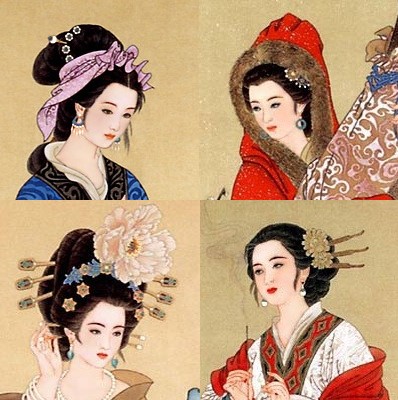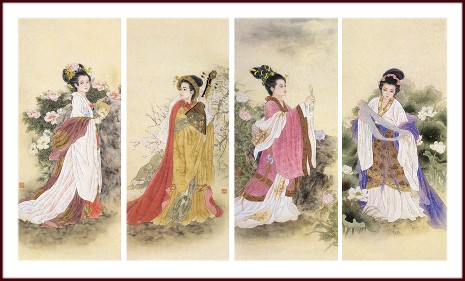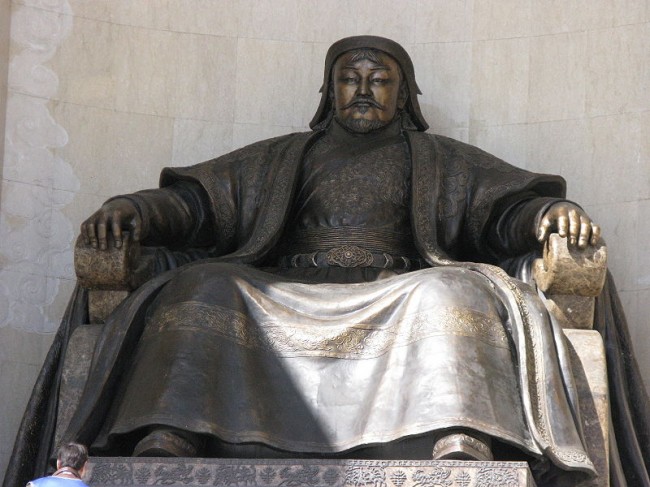Introduction to Four Ancient Beauties of Ancient China
These are the Four Beauties of ancient China (四大美女-Sì Dà Měi Nŭ). And they are historical figures whose lives have been embellished in Chinese literature.

Here’s an introduction as well as a summary of the four beauties:
Xi Shi (西施)
Xi Shi (西施) was born in Zhuluo Village, of Zhuji (now Zhuji City, Zhejiang Province), the capital of ancient Yue State (770-476 BC).
She has widely been considered the most beautiful of ancient China’s “four beauties.” It has been said that while Xi Shi was washing a veil, she caused the fishes to sink to the bottom of the river because the fishes were frozen by her beauty.
During the State Wars, the King of Yue was humiliated by his rival, the King of Wu. After heeding the advice of his minister, Fan Li, of sending the most beautiful woman to King of Wu. Xi Shi was then sent to be offered to King of Wu.
The plan worked. Enchanted by the beauty of Xishi, the King of Wu paid less attention to state affairs, and he became less interested in what his ministers had to say. He spent all his time with her, building for her the extravagant Guanwa Palace (Palace of Beautiful Women) near the city of Suzhou.
The power of Wu State weakened gradually, and King of Wu was eventually conquered by Yue’s army. After the defeat in year 473 BC, King of Wu committed suicide.
Xi Shi is known for being one of the few women who caused an entire kingdom to collapse.
*****
Wang Zhaojun (王昭君)
[showadl]
Wang Zhaojun (王昭君) was born in Zigui County (now Xingshan County, Hubei Province), during the Western Han Dynasty (206 BC-24 AD). She came from a noble background and became part of the imperial harem. She was intelligent and was a skilled pipa player.
Zhaojun, who was straightforward and honest, had refused to bribe the court’s painter, Mao Yanshou, as the others had done. Mao painted portraits—used by the emperor to select the concubines—of the candidates. That prompted Mao to paint an unflattering portrait of Wang. As a result, the emperor overlooked her.
In 33 BC as part of a deal between the Han Chinese and the Xiongnu nomads of Central Asia, Wang Zhaojun was offered to the chieftain Huhanye.
Legend has it that Zhaojun was upset to leave her homeland. She played melancholic music on the pipa, while riding a horse. Then, a flock of geese flew by. But after seeing the beautiful, but distraught, woman playing the sad music, they plummeted to the ground.
Zhaojun was able to foster peaceful relations between China and the Xiongnu, which lasted for 60 years after she traveled beyond the Great Wall. A tomb that was built in her honor lies south of Hohhot in Inner Mongolia.
Read our feature article on Wang Zhaojun.
*****
Diao Chan (貂蝉)
Unlike the other beauties, Diao Chan (貂蝉) was never mentioned in history books, and she might be a fictional figure. Her story is told in the famous historical novel Romance of the Three Kingdoms by Luo Guanzhong. She was the center of a royal love triangle.
Diao Chan was a pretty singer during the Eastern Han Dynasty (25-220 AD), and she resided with the family of Wang Yun, who was an official.
One night, Diao Chan was in the garden, praying to the full moon. Suddenly, a cloud floated by and blocked the moon’s glow. Wang Yun witnessed the event, and he told others, “Diao Chan is more beautiful than the full moon. The moon felt shame and hid behind the cloud.”
According to legend, Diao Chan had joined a plot that was initiated by Wang Yun. The plot was to persuade Lu Bu, to kill his godfather, the despotic Dong Zhuo, who planned to usurp the throne. Wang Yun had Diao Chan became involved with Lu Bu but he later decided to offer her to Dong Zhuo as a concubine. After learning Dong Zhuo had taken Diao Chan as a concubine, Lu Bu was furious and killed Dong Zhuo.
Later, Diao Chan married Lu Bu and they had children. Lu Bu was eventually killed by Cao Cao, and Diao Chan was never heard of again.
*****
Yang Guifei (杨贵妃)
Yang Guifei (杨贵妃), whose name was Yang Yuhuan, was born into an official’s family in Yongle (now Huayin County, Shaanxi Province) in 719 AD, which was during the Tang Dynasty (618-907 AD). In addition to her beauty, Yang was an accomplished singer and dancer. When she was 16, Yang married Prince Shou, who was Emperor Xuanzong’s 18th son.
Attracted by Yang Guifei’s beauty, Emperor Xuanzong wanted to marry her and forced her to divorce Prince Shou. She came to have such influence over the Emperor that many members of her family were appointed to high positions. Among them was Yang Guozhong, who assumed the post of Prime Minister.
Legend has it, one day Yang Guifei walked through the garden. Attracted by the beauty of the flowers, she touched one of the plants. That caused the flower’s petals and leaves to curl. One of the maids witnessed the event, and she told everyone the flower had bowed its head in shame after having seen Yang Guifei’s beautiful face.
Emperor Xuanzong was smitten by Yang Guifei and totally neglected his state affairs. Everyone came to hate her and her family because they felt they were causing the country’s downfall. This led to rebellion on the part of one of Xuanzong’s generals in 755 AD, who marched on the capital. The Emperor fled with Yang Guifei. They didn’t get far when his own royal guard troops refused to march any further unless Yang Guifei and Yang Guozhong were executed. The Emperor could do nothing but bow to their wishes. She chose to commit suicide instead. At age 38, she hanged herself.
*****

Concepts of beauty have changed throughout the various periods of China’s history, but the following 10 characteristics have continuously been considered signs of beauty:
- Lustrous black hair
- Hair loosely coiled on the head to create the appearance of greater height
- Finely shaped black eyebrows. During the Tang Dynasty, many women shaved their eyebrows and they drew eyebrows with pigment
- Large, bright and expressive eyes
- Red lips and white teeth. In addition to beauty, this was considered a sign of good health
- Graceful fingers and arms. A pretty woman was expected to have well-shaped hands, with slim, soft fingers, and fair, fleshy arms
- Slender waist and fair skin. Throughout history, women have wanted a willowy figure
- Tiny feet and a light, elegant gait
- Dressing according to complexion, figure and disposition
- A fragrant body. It’s said a Concubine Xiang (香妃) of Qing Emperor Qian Long (1711-1799) gave off a natural fragrance.
Do come back and check out detailed write ups about these four beauties and their influences in ancient China. 🙂



